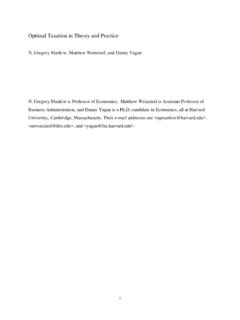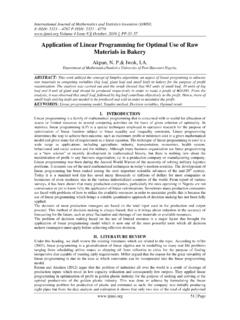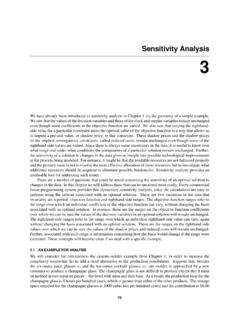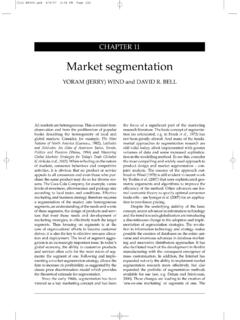Transcription of Chapter 2 The Solow Growth Model (and a look ahead)
1 Chapter 2. The Solow Growth Model (and a look ahead). Centralized Dictatorial Allocations In this section, we start the analysis of the Solow Model by pretending that there is a dictator, or social planner, that chooses the static and intertemporal allocation of resources and dictates that allocations to the households of the economy We will later show that the allocations that prevail in a decentralized competitive market environ- ment coincide with the allocations dictated by the social planner. The Economy, the Households and the Dictator Time is discrete, t {0, 1, 2, ..}. You can think of the period as a year, as a generation, or as any other arbitrary length of time. The economy is an isolated island. Many households live in this island. There are 9. George-Marios Angeletos no markets and production is centralized. There is a benevolent dictator, or social planner, who governs all economic and social a airs. There is one good, which is produced with two factors of production, capital and labor, and which can be either consumed in the same period, or invested as capital for the next period.
2 Households are each endowed with one unit of labor, which they supply inelasticly to the social planner. The social planner uses the entire labor force together with the accumulated aggregate capital stock to produce the one good of the economy. In each period, the social planner saves a constant fraction s (0, 1) of contemporane- ous output, to be added to the economy's capital stock, and distributes the remaining fraction uniformly across the households of the economy. In what follows, we let Lt denote the number of households (and the size of the labor force) in period t, Kt aggregate capital stock in the beginning of period t, Yt aggregate output in period t, Ct aggregate consumption in period t, and It aggregate investment in period t. The corresponding lower-case variables represent per-capita measures: kt =. Kt /Lt , yt = Yt /Lt , it = It /Lt , and ct = Ct /Lt . Technology and Production The technology for producing the good is given by Yt = F (Kt , Lt ) ( ).
3 Where F : R2+ R+ is a (stationary) production function. We assume that F is continuous and (although not always necessary) twice di erentiable. 10. Lecture Notes We say that the technology is neoclassical if F satisfies the following properties 1. Constant returns to scale (CRS), or linear homogeneity: F ( K, L) = F (K, L), > 0. 2. Positive and diminishing marginal products: FK (K, L) > 0, FL (K, L) > 0, FKK (K, L) < 0, FLL (K, L) < 0. where Fx F/ x and Fxz 2 F/( x z) for x, z {K, L}. 3. Inada conditions: lim FK = lim FL = , K 0 L 0. lim FK = lim FL = 0. K L . By implication, F satisfies Y = F (K, L) = FK (K, L)K + FL (K, L)L. or equivalently 1 = K + L. where F K F L. K and L . K F L F. Also, FK and FL are homogeneous of degree zero, meaning that the marginal products depend only on the ratio K/L. And, FKL > 0, meaning that capital and labor are complementary. Finally, all inputs are essential: F (0, L) = F (K, 0) = 0. 11. George-Marios Angeletos Technology in intensive form: Let Y K.
4 Y= and k= . L L. Then, by CRS. y = f (k) ( ). where f (k) F (k, 1). By definition of f and the properties of F, f (0) = 0, f 0 (k) > 0 > f 00 (k). lim f 0 (k) = , lim f 0 (k) = 0. k 0 k . Also, FK (K, L) = f 0 (k). FL (K, L) = f (k) f 0 (k)k The intensive-form production function f and the marginal product of capital f 0 are illustrated in Figure 1. Example: Cobb-Douglas technology F (K, L) = K L1 . In this case, K = , L = 1 . and f (k) = k . 12. Lecture Notes The Resource Constraint, and the Law of Motions for Cap- ital and Labor Remember that there is a single good, which can be either consumed or invested. Of course, the sum of aggregate consumption and aggregate investment can not exceed aggregate output. That is, the social planner faces the following resource constraint: Ct + It Yt ( ). Equivalently, in per-capita terms: ct + it yt ( ). Suppose that population Growth is n 0 per period. The size of the labor force then evolves over time as follows: Lt = (1 + n)Lt 1 = (1 + n)t L0 ( ).
5 We normalize L0 = 1. Suppose that existing capital depreciates over time at a fixed rate [0, 1]. The capital stock in the beginning of next period is given by the non-depreciated part of current-period capital, plus contemporaneous investment. That is, the law of motion for capital is Kt+1 = (1 )Kt + It . ( ). Equivalently, in per-capita terms: (1 + n)kt+1 = (1 )kt + it 13. George-Marios Angeletos We can approximately write the above as kt+1 (1 n)kt + it ( ). The sum + n can thus be interpreted as the e ective depreciation rate of per- capita capital. (Remark: This approximation becomes arbitrarily good as the economy converges to its steady state. Also, it would be exact if time was continuous rather than discrete.). The Dynamics of Capital and Consumption In most of the Growth models that we will examine in this class, the key of the analysis will be to derive a dynamic system that characterizes the evolution of aggregate con- sumption and capital in the economy; that is, a system of di erence equations in Ct and Kt (or ct and kt ).
6 This system is very simple in the case of the Solow Model . Combining the law of motion for capital ( ), the resource constraint ( ), and the technology ( ), we derive the di erence equation for the capital stock: Kt+1 Kt F (Kt , Lt ) Kt Ct ( ). That is, the change in the capital stock is given by aggregate output, minus capital depreciation, minus aggregate consumption. kt+1 kt f (kt ) ( + n)kt ct . Remark. Frequently we write the above constraints with equality rather than inequal- ity, for, as longs as the planner/equilibrium does not waste resources, these constraints will indeed hold with equality. 14. Lecture Notes Feasible and optimal Allocations 2 . Definition 1 A feasible allocation is any sequence {ct , kt } . t=0 R+ that satisfies the resource constraint kt+1 f (kt ) + (1 n)kt ct . ( ). The set of feasible allocations represents the "choice set" for the social planner. The planner then uses some choice rule to select one of the many feasible allocations.
7 Later, we will have to social planner choose an allocation so as to maximize welfare. Here, we instead assume that the dictaror follows a simple rule-of-thump. In particular, consumption is, by assumption, a fixed fraction (1 s) of output: Ct = (1 s)Yt ( ). Similarly, in per-capita terms, ( ), ( ) and ( ) give the dynamics of capitalwhereas consumption is given by ct = (1 s)f (kt ). From this point and on, we will analyze the dynamics of the economy in per capita terms only. Translating the results to aggregate terms is a straightforward exercise. Definition 2 An optimal centralized allocation is any feasible allocation that satisfies the resource constraint with equality and ct = (1 s)f (kt ). ( ). Remark. In the Ramsey Model , the optimal allocation will maximize social welfare. Here, the optimal allocation satisfies the presumed rule-of-thump for the planner. 15. George-Marios Angeletos The Policy Rule Combining ( ) and ( ), we derive the fundamental equation of the Solow Model : kt+1 kt = sf (kt ) ( + n)kt ( ).
8 Note that the above defines kt+1 as a function of kt : Proposition 3 Given any initial point k0 > 0, the dynamics of the dictatorial economy are given by the path {kt } . t=0 such that kt+1 = G(kt ), ( ). for all t 0, where G(k) sf (k) + (1 n)k. Equivalently, the Growth rate of capital is given by kt+1 kt t = (kt ), ( ). kt where (k) s (k) ( + n), (k) f (k)/k. Proof. ( ) follows from ( ) and rearranging gives ( ).. G corresponds to what we will call the policy rule in the Ramsey Model . The dynamic evolution of the economy is concisely represented by the path {kt } . t=0 that satisfies ( ), or equivalently ( ), for all t 0, with k0 historically given. The graph of G is illustrated in Figure 2. 16. Lecture Notes Remark. Think of G more generally as a function that tells you what is the state of the economy tomorrow as a function of the state today. Here and in the simple Ramsey Model , the state is simply kt . When we introduce productivity shocks, the state is (kt , At ).
9 When we introduce multiple types of capital, the state is the vector of capital stocks. And with incomplete markets, the state is the whole distribution of wealth in the cross-section of agents. Steady State A steady state of the economy is defined as any level k such that, if the economy starts with k0 = k , then kt = k for all t 1. That is, a steady state is any fixed point k of ( ) or ( ). Equivalently, a steady state is any fixed point (c , k ) of the system ( )-( ). A trivial steady state is c = k = 0 : There is no capital, no output, and no consumption. This would not be a steady state if f (0) > 0. We are interested for steady states at which capital, output and consumption are all positive and finite. We can easily show: Proposition 4 Suppose +n (0, 1) and s (0, 1). A steady state (c , k ) (0, )2 for the dictatorial economy exists and is unique. k and y increase with s and decrease with and n, whereas c is non-monotonic with s and decreases with and n.
10 Finally, y /k = ( +n)/s. Proof. k is a steady state if and only if it solves 0 = sf (k ) ( + n)k , Equivalently y +n = (k ) = ( ). k s 17. George-Marios Angeletos where f (k). (k) . k The function gives the output-to-capital ratio in the economy. The properties of f imply that is continuous (and twice di erentiable), decreasing, and satisfies the Inada conditions at k = 0 and k = : 0 f 0 (k)k f (k) FL. (k) = 2. = 2 < 0, k k (0) = f 0 (0) = and ( ) = f 0 ( ) = 0, where the latter follow from L'Hospital's rule. This implies that equation ( ) has a solution if and only if + n > 0 and s > 0. and the solution unique whenever it exists. The steady state of the economy is thus unique and is given by . 1 +n k = . s Since 0 < 0, k is a decreasing function of ( + n)/s. On the other hand, consumption is given by c = (1 s)f (k ). It follows that c decreases with + n, but s has an ambiguous e ect. Parenthesis: Global and Local Stability Discuss the stability properties of a dynamic system: Eigenvalues, cycles, continuous vs discrete time.

















